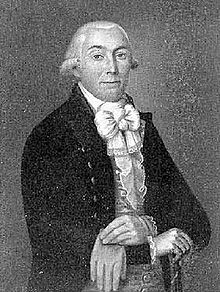Friedrich Philipp Stumm
Friedrich Philipp Stumm (born March 11, 1751 in Abentheuer ; † November 8, 1835 in Saarbrücken ) was a German coal and steel entrepreneur and one of the three co-founders of the Stumm brothers .

Life
He was the son of Johann Heinrich Stumm (1710–1783) from the mining entrepreneur family Stumm . He attended grammar school in Trarbach and completed a commercial training in Cologne . This was followed by a stay in Nancy to learn French. At the age of thirty he took over the Asbacherhütte . Together with his brother Johann Ferdinand Stumm, he managed the family business. Johann Ferdinand was responsible for the operations in the Hunsrück . He also concentrated on the more commercial part of the job. In contrast, despite his commercial training, Friedrich Philipp was responsible for the technical area. The brothers acquired the Graefenbacher Hütte near Spabrücken in 1785 . On November 19, 1789, he married Maria Elisabeth Geib in Lambsheim (* November 1, 1770; † January 2, 1800).
Both brothers lived in Saarbrücken after 1800 . Friedrich Philipp lived in the Mendel Palace, his brother in the Saarbrücken Castle . Together with their brother Christian Philipp Stumm , Friedrich Philipp and Johann Ferdinand founded the open trading company Gebrüder Stumm in 1806. This included the plants on the Saar and in the Hunsrück. As a councilor in Mannheim, Christian Philipp played no role in the actual management of the company, except in legal questions.
During the Wars of Liberation , Friedrich Philipp supported the anti-French forces. With him lodged Gebhard Leberecht von Blücher , August Neidhardt von Gneisenau and other high-ranking officers in the advance into France.
The brothers acquired the Neunkircher ironworks in 1808 , and in 1809 the Halberger and Fischbacher ironworks, partly together with other shareholders. In addition, they later owned shares in Dillinger Hütte . Their course was largely shaped by the main limited partners Stumm. In 1828 they also acquired the Geislautern hut .
Between 1824 and 1828 Christian Philipp and Johann Ferdinand left the company. There were no inheritance problems and the company's financial strength was not weakened. Friedrich Philipp's son Carl Friedrich Stumm joined the company as a new partner . The father held five sixths and the son one sixth of the shares. The son began the puddling process in 1829 , while the father delayed innovations. It is significant that the introduction of the steam engine was only possible after the death of the father.
After the death of Friedrich Philipp the property was divided. The husband of the daughter Charlotte Henriette, Heinrich Böcking , received the works in the Hunsrück. The son Carl Friedrich got the business in the Saar district.
Individual evidence
- ↑ Chris Nees: Rauischholzhausen Castle. Norderstedt 2010, p. 16
literature
- Ralf Banken: The industrialization of the Saar region. 1815-1914. Vol. 1. The early industrialization 1815-1850. Stuttgart, 2000 ISBN 3-515-07324-8
Web links
| personal data | |
|---|---|
| SURNAME | Mute, Friedrich Philipp |
| BRIEF DESCRIPTION | German entrepreneur |
| DATE OF BIRTH | March 11, 1751 |
| PLACE OF BIRTH | Adventure |
| DATE OF DEATH | November 8, 1835 |
| Place of death | Saarbrücken |
